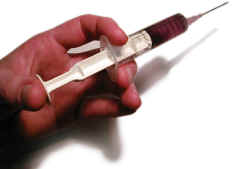 Home
Search This Site
Chiropractic Articles
Home
Search This Site
Chiropractic Articles
|
Vaccinations, Are They Really Necessary?
Vaccinations are something that have become popular over the last half
a century. In spite of the fact that there are numerous The FDA's VAERS (Vaccine Adverse Effects Reporting System) receives about 11,000 reports of serious adverse reactions to vaccination annually, some 1% (112+) of which are deaths from vaccine reactions.[1] The majority of these reports are made by doctors, and the majority of deaths are attributed to the pertussis (whooping cough) vaccine, the "P" in DPT. This figure alone is alarming, yet it is only the "tip of the iceberg." The FDA estimates that only about 10% of adverse reactions are reported, [2] a figure supported by two National Vaccine Information Center (NVIC) investigations. [3] In fact, the NVIC reported that "In New York, only one out of 40 doctor's offices [2.5%] confirmed that they report a death or injury following vaccination," -- 97.5% of vaccine related deaths and disabilities go unreported there. Implications about the integrity of medical professionals aside (doctors are legally required to report serious adverse events), these findings suggest that vaccine deaths actually occurring each year may be well over 1,000. "Vaccines are very effective..." ...or are they?The medical literature has a surprising number of studies documenting vaccine failure. Measles, mumps, small pox, polio and Hib outbreaks have all occurred in vaccinated populations. [11, 12, 13, 14 ,15] In 1989 the CDC reported: "Among school-aged children, [measles] outbreaks have occurred in schools with vaccination levels of greater than 98 percent. [16] [They] have occurred in all parts of the country, including areas that had not reported measles for years." [17] The CDC even reported a measles outbreak in a documented 100 percent vaccinated population. [18] A study examining this phenomenon concluded, "The apparent paradox is that as measles immunization rates rise to high levels in a population, measles becomes a disease of immunized persons." [19] A more recent study found that measles vaccination "produces immune suppression which contributes to an increased susceptibility to other infections."[19a] These studies suggests that the goal of complete immunization is actually counterproductive, a notion underscored by instances in which epidemics followed complete immunization of entire countries. Japan experienced yearly increases in small pox following the introduction of compulsory vaccines in 1872. By 1892, there were 29,979 deaths, and all had been vaccinated. [20] Early in this century, the Philippines experienced their worst smallpox epidemic ever after 8 million people received 24.5 million vaccine doses; the death rate quadrupled as a result. [21] In 1989, the country of Oman experienced a widespread polio outbreak six months after achieving complete vaccination. [22] In the U.S. in 1986, 90% of 1300 pertussis cases in Kansas were "adequately vaccinated." [23] 72% of pertussis cases in the 1993 Chicago outbreak were fully up to date with their vaccinations.[24] INFORMATION SOURCES:(1) National Technical Information Service, Springfield, VA 22161, 703-487-4650,
703-487-4600. (4) Viera Scheibner, Ph.D., Vaccination: 100 Years of Orthodox Research Shows that
Vaccines Represent a Medical Assault on the Immune System. (6) Confounding in studies of adverse reactions to vaccines [see comments]. Fine PE, Chen RT, REVIEW ARTICLE: 38 REFS. Comment in: Am J Epidemiol 1994 Jan 15;139(2):229-30. Division of Immunization, Centers for Disease Control, Atlanta, GA 30333. (7) Nature and Rates of Adverse Reactions Associated with DTP and DT Immunizations in
Infants and Children" (Pediatrics, Nov. 1981, Vol. 68, No. 5) (10) National Vaccine Injury Compensation Program (NVICP), Health Resources and Services Administration, Parklawn Building, Room 7-90, 5600 Fishers Lane, Rockville, MD 20857, 800-338-2382. (11) Measles vaccine failures: lack of sustained measles specific immunoglobulin G
responses in revaccinated adolescents and young adults. Department of Pediatrics,
Georgetown University Medical Center, Washington, DC 20007. Pediatric Infectious Disease
Journal. 13(1):34-8, 1994 Jan. (16) MMWR, 38 (8-9), 12/29/89). (20) Trevor Gunn, Mass Immunization, A Point in Question, p 15 (E.D. Hume, Pasteur
Exposed-The False Foundations of Modern Medicine, Bookreal, Australia, 1989.) |
 complications associated with
vaccinations, mainstream America and now the world are still being constantly enticed into
believing that vaccinations are a good thing. Vaccinations are made of many toxic
substances including formaldehyde, mercury and more. The use of vaccines has been
implicated in Autism, Hyperactivity, AIDS, MS, and Cancer.
complications associated with
vaccinations, mainstream America and now the world are still being constantly enticed into
believing that vaccinations are a good thing. Vaccinations are made of many toxic
substances including formaldehyde, mercury and more. The use of vaccines has been
implicated in Autism, Hyperactivity, AIDS, MS, and Cancer.